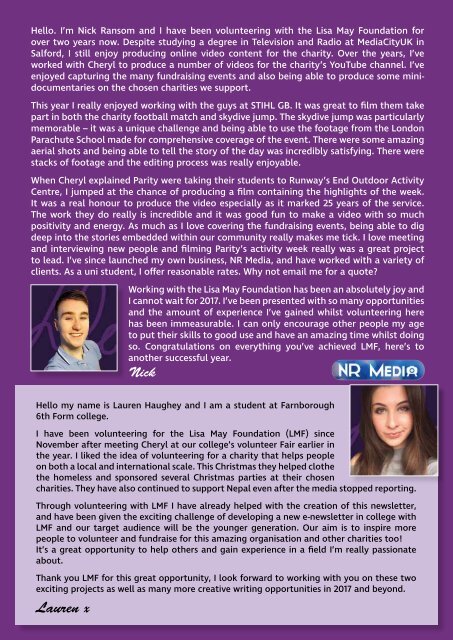Final NEWSLETTER _LR
Create successful ePaper yourself
Turn your PDF publications into a flip-book with our unique Google optimized e-Paper software.
Hello. I’m Nick Ransom and I have been volunteering with the Lisa May Foundation for<br />
over two years now. Despite studying a degree in Television and Radio at MediaCityUK in<br />
Salford, I still enjoy producing online video content for the charity. Over the years, I’ve<br />
worked with Cheryl to produce a number of videos for the charity’s YouTube channel. I’ve<br />
enjoyed capturing the many fundraising events and also being able to produce some minidocumentaries<br />
on the chosen charities we support.<br />
This year I really enjoyed working with the guys at STIHL GB. It was great to film them take<br />
part in both the charity football match and skydive jump. The skydive jump was particularly<br />
memorable – it was a unique challenge and being able to use the footage from the London<br />
Parachute School made for comprehensive coverage of the event. There were some amazing<br />
aerial shots and being able to tell the story of the day was incredibly satisfying. There were<br />
stacks of footage and the editing process was really enjoyable.<br />
When Cheryl explained Parity were taking their students to Runway’s End Outdoor Activity<br />
Centre, I jumped at the chance of producing a film containing the highlights of the week.<br />
It was a real honour to produce the video especially as it marked 25 years of the service.<br />
The work they do really is incredible and it was good fun to make a video with so much<br />
positivity and energy. As much as I love covering the fundraising events, being able to dig<br />
deep into the stories embedded within our community really makes me tick. I love meeting<br />
and interviewing new people and filming Parity’s activity week really was a great project<br />
to lead. I’ve since launched my own business, NR Media, and have worked with a variety of<br />
clients. As a uni student, I offer reasonable rates. Why not email me for a quote?<br />
Working with the Lisa May Foundation has been an absolutely joy and<br />
I cannot wait for 2017. I’ve been presented with so many opportunities<br />
and the amount of experience I’ve gained whilst volunteering here<br />
has been immeasurable. I can only encourage other people my age<br />
to put their skills to good use and have an amazing time whilst doing<br />
so. Congratulations on everything you’ve achieved LMF, here’s to<br />
another successful year.<br />
Nick<br />
Hello my name is Lauren Haughey and I am a student at Farnborough<br />
6th Form college.<br />
I have been volunteering for the Lisa May Foundation (LMF) since<br />
November after meeting Cheryl at our college’s volunteer Fair earlier in<br />
the year. I liked the idea of volunteering for a charity that helps people<br />
on both a local and international scale. This Christmas they helped clothe<br />
the homeless and sponsored several Christmas parties at their chosen<br />
charities. They have also continued to support Nepal even after the media stopped reporting.<br />
Through volunteering with LMF I have already helped with the creation of this newsletter,<br />
and have been given the exciting challenge of developing a new e-newsletter in college with<br />
LMF and our target audience will be the younger generation. Our aim is to inspire more<br />
people to volunteer and fundraise for this amazing organisation and other charities too!<br />
It’s a great opportunity to help others and gain experience in a field I’m really passionate<br />
about.<br />
Thank you LMF for this great opportunity, I look forward to working with you on these two<br />
exciting projects as well as many more creative writing opportunities in 2017 and beyond.<br />
Lauren x<br />
Are natural disasters increasing,<br />
and is it our fault?<br />
In recent years we’ve seen a series of natural<br />
disasters causing devastation through the<br />
destruction of lives and livelihoods across the<br />
globe. From the Boxing Day Tsunami in 2004, to the<br />
violent earthquake that shook Nepal in 2015 - we’ve<br />
seen it all...Or have we? There’s a new question<br />
striking concern in our hearts. Are natural disasters<br />
increasing, and is it our fault?<br />
Using evidence found from historic data, satellite<br />
imagery and other sources we are able to identify<br />
a change in the global pattern of natural disasters<br />
and understand what’s going on. Accuweather<br />
shockingly says that “There were three times as<br />
many natural disasters between 2000 to 2009<br />
compared to the amount between 1980 and 1989. A<br />
vast majority (80%) of this growth is due to climaterelated<br />
events.”. NASA also agrees that natural<br />
disasters related to climate are surging, stating that<br />
there is an “increased risk of drought and increased<br />
intensity of storms, including tropical cyclones with<br />
higher wind speeds”. It is noticeable that all these<br />
hazards mentioned are linked to climate...But what<br />
is the link?<br />
The answer is simple: climate is changing and<br />
temperatures are rising. This means that Earth<br />
has the perfect conditions to stir up some more<br />
hurricanes, more water-stressed conditions, and<br />
more wildfires with bolstered power. The change<br />
in climate is down to a phenomena known as<br />
the ‘Greenhouse Effect’, meaning that gases are<br />
trapped in Earth’s atmosphere which cause our<br />
planet to swelter.<br />
The effect is actually a natural process, but the rate<br />
at which it occurs has been enhanced by human<br />
activity, causing it to be more harmful. This is a<br />
result of actions we take daily that emit greenhouse<br />
gas emissions, including gases like carbon-dioxide<br />
and methane. The BBC Weather Centre states that<br />
carbon-dioxide is “currently responsible for 60%<br />
of the ‘enhanced greenhouse effect’ “ and “Since<br />
the Industrial Revolution the concentration globally<br />
has increased by about 40%”.<br />
This demonstrates that there<br />
is a clear link between human<br />
activity and greenhouse gas<br />
emissions,<br />
image courtesy: blogs.edf.org<br />
due to the technological<br />
changes we made in the<br />
Industrial Period. This<br />
includes changes to<br />
transport, such as our<br />
increased use of train<br />
lines and cars which<br />
release carbon-dioxide<br />
emissions. In fact, the Scientific American Podcast<br />
states that in 2007 car usage was the second largest<br />
source of these emissions, releasing 1.2 billion<br />
metric tonnes carbon-dioxide into our atmosphere.<br />
It is therefore no surprise that gas emissions have<br />
soared by a record breaking “30 parts per million<br />
(ppm) in the past two decades”, as told by the<br />
American Chemical Society (ACS). Something<br />
we’ve never seen before, and something that is<br />
quite concerning.<br />
Another human cause of greenhouse gas emissions<br />
is our increased consumption of food at restaurants,<br />
such as burger-chains. One reason for this is given<br />
to the fact that many of these restaurants carry out<br />
deforestation in order to make space for the cows<br />
they breed to feed our mouths. In fact, Mongabay.<br />
com says that in the Amazon Rainforest “more<br />
than 60 percent of deforested land ends up as<br />
cattle pasture” demonstrating that a lot of trees are<br />
butchered purely for this purpose. Deforestation<br />
occurs on a massive scale and is another cause<br />
for enhancing our global temperatures through<br />
the Greenhouse Effect. This is because trees<br />
store carbon and transform it into food. So,<br />
when there are more trees, less carbon-dioxide is<br />
emitted into the atmosphere. The WWF says that<br />
“46-58 thousand square miles of forest are lost<br />
each year—equivalent to 48 football fields every<br />
minute.”. This horrendous figure is responsible for<br />
“15% of all greenhouse gas emissions”, and as<br />
consequence conveys the effect humans have on<br />
our future in terms of increased temperatures and<br />
natural disaster severity.<br />
With this in mind, there is all the more reason to<br />
support the Lisa May Foundation. They generously<br />
give aid to those suffering from natural disaster<br />
devastation, and the positive result is clear to see<br />
in this newsletter.<br />
Lauren x<br />
The views and opinions expressed in this article are those of the authors<br />
and do not necessarily reflect the views of the Foundation.





